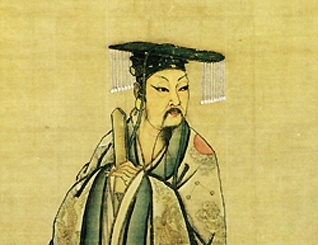The Xia Dynasty was the first traditional Chinese dynasty in recorded history. It began in 2070 B.C.E and eventually came to an end around the year 1600 B.C.E. In ancient Chinese tradition, the Xia Dynasty was started by Yu the Great, who was a great decedent of one of the mythical five great Emperors, Zhuanxu. Before historians in the 20th century discovered physical evidence of the dynasty’s existence, it was thought to be only legend. The Xia was eventually overthrown by the Shang Dynasty, which historians are certain existed. Using facts and data discovered in recent times, there has been enough evidence found to show that the Xia Dynasty did in fact exist.1

The Xia Dynasty was therefore the first real government in Chinese history. It was the first to install the practice of dynastic succession. According to many historians, a great ruler named Huang-ti, better known as the Yellow Emperor, created the traditional Chinese culture we know today. Gun, the father of Yu the Great, was the first recorded member of the Xia. During his lifetime, the great floods of the Yellow River occurred. Due to the fact that the Xia Dynasty has been shrouded in mystery, it has been discovered recently that these floods did indeed occur. According to written documents and oral tradition, Gun was appointed to stop the flooding. He ordered the construction of large walls to attempt to control the path of the water. Gun attempted to stop the floods, which lasted for nine years, but ultimately ended in failure due to the repetition of the flood’s destruction. Eventually, Yu, who was highly trusted by Shun, was appointed to continue his father’s life work, and was successfully able to stop the flooding. Yu’s method was different from his father’s. He organized groups of people from different tribes and ordered them to help build canals as flood channels along the Yellow River to divert its destructive floodwaters. This would eventually lead the water out to the sea. People praised his hard working nature and were so inspired that more tribes began to join in on the attempts to stop the flooding. Yu did not slack when it came to his work. Verbal legends say that in the thirteen years it took him to complete the work, he never returned to his home village to stop and rest. It is even said that he passed by his home three times without visiting his family.2
This account of the great floods has been often regarded as mythical by many historians in the past. However, there is now solid evidence that these floods did in fact take place. Archaeological evidence has been uncovered about a large flood that destroyed a portion of different cities on the upper reaches of the Yellow River dating back to about 1920 BCE. This date is right before the rise of the Erlitou culture, which was located in the middle Yellow River valley. Some scholars now suggest that this flood may have been the basis for the later myth, and a main contributor to the transition of cultures. They also argue that the timing is more concrete evidence for the identification of the Xia with the Erlitou culture. However, no evidence of mass flooding in the northern regions of the Yellow River has been discovered.3
Apart from the stories of the flooding, there are even more questions raised due to newly discovered evidence. There have been many artifacts found including engravings on animal bones, which points to evidence for the second dynasty, the Shang. At one point, it controlled an area in the Yellow river basin about 3,500 years ago. There have been no similar confirmation for the existence of the mysterious Xia Dynasty. Even from inside China, some historians have long suspected that the country’s original timeline passing down through tradition is false. Emperor Yu completely stopping the floods on the Yellow river and establishing the first dynasty was either a myth that could be compared to the story of Noah’s Ark, or as propaganda invented later to justify to the people how centralized state power came about. Recently, state-controlled media have been discussing newly published evidence in an American journal titled Science that the flooding was in fact real. This has provided credible evidence that suggests that the Xia Dynasty was also real.4
Even though there is little solid evidence that the Xia Dynasty did actually exist, all the stories and pieces of information point to realness of this ancient Chinese dynasty. At the end of this, many still believe that the Xia Dynasty did exist and that more evidence will eventually be found to demonstrate that it did.
- Ancient History Encyclopedia, 2016, s.v. “Xia Dynasty,” by Emily Mark. ↵
- Qinglong Wu et al., “Outburst Flood At 1920 BCE Supports Historicity Of China’s Great Flood And The Xia Dynasty,” Science vol. 353, no. 6299 (2016): 25-32. ↵
- Liu Kang, “Xia Dynasty Evidence: Remains Indicate China Did Have Great Flood,” The Japan Times, January 2016. ↵
- Casey Day, “The Return of the Xia,” The Economist, August 20, 2016. ↵



36 comments
Janaya Felder
It’s weird how water can wipe so much away. I’m glad that there has been concrete evidence of the flooding but it’s interesting that there is some question to whether or not the Xia dynasty existed. A lot of evidence points to it existing but I suppose more research would have to be conducted in order to solidify the pre-existing evidence.
M. Hu
basically because of the missing of text evidence, it is very unlikely to prove that Erlitou culture is indeed Xia dynasty. But the existence Erlitou culture does prove that a dynasty exist in the historical period the history record later called Xia dynasty, whether it is Xia or not, maybe but we are not sure.
Wolfgang Bensvage
The water was because of the meld of ice water due to the rising of temperature worldwidely. And, the Erlitou, actually the physical ruins in Henan province in China, has been studied by researchers and experts for decades. Enough evidence~~
Melissa Garza
I definitely learned about the Xia dynasty at my high school but I really don’t remember much about the content. I found this article really interesting because we really do not know whether or not things in our history happened or not. There is no true record to show events like these back in the B.C.E time period. That is so far back I cannot even imagine what life was like. Great article Desmond! One of the most interesting articles I have read.
Edith Santos Sevilla
I remember reading about the Xia dynasty when I was in high school, but there was not much that I could remember. There were many things that I remember, but the majority was new information and it was very interesting. It is fascinating how some much time in history is not confirmed if it did happened. Even after the majority of the facts known point that the Xia dynasty did exist, not all of the information has totally proven all of the events recorded actually happened.
Roberto Rodriguez
It is always interesting to uncover previously unknown information about our human history, it is crazy to think that we do not know everything about ourselves. It is almost out of a movie, that a myth is found to be fact, it is especially interesting that the stories seemed to be exactly that… stories. They just seem to be so far-fetched, that they just could not be true, but I guess time and evidence has proven us wrong, and those extraordinary events actually happened. It is good to know that we have found another part of our human history, and we can learn a little bit more about out past.
Michael Hinojosa
Talk about an amazing article! I’ve always been interested in the history about a lot of ancient dynasties, kingdoms, and just the history of other countries in general; So you could imagine my interest when I saw an article about the first ever dynasty: The Xia Dynasty. I myself still can’t believe that this dynasty was cast as fiction rather than fact, but I’m glad we were able to muster up enough evidence to prove that it did in fact exist!
Ava Rodriguez
This was an interesting article to read, especially because I do not know too much about Chinese history. It is crazy to think how the Xia dynasty was considered fiction. Now that proof has been discovered, the Xia dynasty actually did exist. It is amazing how even through very destructive floods, the Xia dynasty built canals to protect their villages. As well as other evidence that proves that the Xia dynasty did exist.
Samantha Ruvalcaba
The writer did a tremendous job titling their article because it was what reeled me in. Upon reading it, I initially thought that researchers would need physical proof like artifacts to know for sure that the Xing Dynasty existed. That was one of the first things answered in this article. It interesting to read how occurrences like the great floods were once believed to be fiction, and now all of this evidence is being accounted for, proving that the Xia dynasty was more than just fiction.
Matthew Swaykus
This article was very interesting. I am not familiar with Chinese history, but I do know that the explanation for why the Xia dynasty was formed is very sound. Mesopotamian societies dealt with devastating floods that are believed to have inspired that Noah’s story of the Great flood; logically speaking, a prevention of a similar flood from occurring along the Yellow river would prompt the people of other tribes to join the Xia Dynasty for the assurance of protection.
Bictor Martinez
I have never heard of the Xia Dynasty before reading this article. I did not know that their civilization was in constant threat due to the massive amount of flood that occurred for 9 years. Luckily, Yu was able to come up with a solution to stop the flooding. The Xia Dynasty will never be for certain as to whether it occurred or not however, hearing the stories that they had to endure in their civilizations amazes me. Great article.
Alexander Manibusan
I’ve only heard of the Xia dynasty, but I never knew that there’s some evidence to prove that the dynasty exists. Much like Troy, no one believed it was a real city until archeological evidence said otherwise. But if historians are certain that the Shang dynasty existed, why not believe the same with the Xia? Nonetheless, it’s amazing to see fact and fiction weave together, and finding what parts are true seems satisfying.